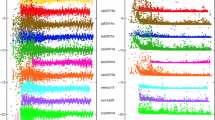Abstract
In this paper, we discuss the fundamental aspects of the semi-analytical precession–nutation models that were adopted by IAU Resolutions in 2000 and 2006. We show that no significant discrepancies appear between those models (Mathews et al., J Geophys Res 107:B4, ETG 3-1–3-26, 2002, Capitaine et al., Astron Astrophys 412:567– 586, 2003) and other semi-analytical solutions or the INPOP06 numerical integration (Fienga et al., Astron Astrophys 477:315–327, 2008), especially for the quadratic terms. We also report on the most recent comparisons of the models with VLBI observations. We have employed different empirical models to fit the residuals, in attempting to characterize the nature of the observed curvature. The efficiencies of those empirical models are compared and their interpretations in terms of physical mechanisms are discussed. We show that a combination of linear and 18.6-year corrections is the most credible model for explaining the currently observed residuals, but that a longer span of observations is required before the true character of the effect can be determined. We note that the predictions from the ERA-2005 theory (Krasinsky, Celest Mech Dyn Astron 96:169–217, 2006) have diverged from recent VLBI results and suggest that the empirical nature of the ERA model is responsible.
Similar content being viewed by others
References
Bourda G., Capitaine N.: Precession, nutation, and space geodetic determination of the Earth’s variable gravity field. Astron. Astrophys. 428, 691–702 (2004)
Bretagnon P., Fienga A., Simon J.-L.: Expressions for precession consistent with the IAU 2000A model. Considerations about the ecliptic and the Earth Orientation Parameters. Astron. Astrophys. 400, 785–790 (2003)
Brumberg, V.: Essential Relativistic Celestial Mechanics. Adam Hilger, Bristol (1991)
Buffett, B.A., Mathews, P.M., Herring, T.A.: Modeling of nutation and precession: effects of electromagnetic coupling. J. Geophys. Res. 107, B4, ETG 5-1–5-14 (2002). doi:10.1029/2000JB000056
Capitaine N., Wallace P.T., Chapront J.: Expressions for IAU 2000 precession quantities. Astron. Astrophys. 412, 567–586 (2003)
Capitaine, N., Mathews, P.M., Dehant, V., Wallace, P.T., Lambert, S.: Comparisons of precession-nutation models. In: Finkelstein, A., Behrend, D. (eds.) Proceedings of the fifth IVS General Meeting, Russian Science Series pp. 211–220 (2008)
Chapront J., Chapront-Touzé M., Francou G.: A new determination of lunar orbital parameters, precession constant and tidal acceleration from LLR measurements. Astron. Astrophys. 387, 700–709 (2002)
Cheng M., Tapley B.D.: Variations in the Earth’s oblateness during the past 28 years. J. Geophys. Res. 109(B9), B09402 (2004). doi:10.1029/2004JB003028
Fienga A., Manche H., Laskar J., Gastineau M.: INPOP06: a new numerical planetary ephemeris. Astron. Astrophys. 477, 315–327 (2008)
Fukushima T.: New precession formulas. Astron. J. 126(1), 494–534 (2003)
Hilton J.L., Capitaine N., Chapront J. et al.: Report of the International Astronomical Union Division I working group on precession and the ecliptic. Celest. Mech. Dyn. Astron. 94, 351–367 (2006)
IERS Conventions 2003, IERS Technical Note 32. McCarthy, D.D., Petit, G. (eds.) Verlag des Bundesamts für Kartographie und Geodäsie, Frankfurt am Main (2004)
Koot L., Rivoldini A., de Viron O., Dehant V.: Estimation of Earth interior parameters from a Bayesian inversion of very long baseline interferometry nutation time series. J. Geophys. Res. 113(B8), B08414 (2008)
Krasinsky G.: Numerical theory of rotation of the deformable Earth with the two-layer fluid core. Part 1: Mathematical model. Celest. Mech. Dyn. Astron. 96, 169–217 (2006)
Krasinsky, G.: Secular decrease of the Earth’s ellipticity from the analysis of VLBI data of 1984–2006, and the long-term systematic errors of the precession-nutation models IAU 2000 and IAU 2006. In: Finkelstein, A., Behrend, D. (eds.) Proceedings of the fifth IVS General Meeting, Russian Science Series, pp. 211–220 (2008a)
Krasinsky G.: Earth’s precession-nutation motion: the error analysis of the theories IAU 2000 and IAU 2006 applying the VLBI data of the years 1984–2006. Celes. Mech. Dyn. Astron. 101, 325–336 (2008b)
Krasinsky G., Vasilyev M.V.: Numerical theory of rotation of the deformable Earth with the two-layer fluid core. Part 2: fitting to VLBI data. Celest. Mech. Dyn. Astron. 96, 219–237 (2006)
Lambert, S.B., Mathews, P.M.: Second-order torque on the tidal redistribution and the Earth’s rotation. Astron. Astrophys. 453, 363–369 (2006), and Erratum, Astron. Astrophys. 481(3), 883–884 (2008)
Mathews, P. M., Lambert, S.B.: Effect of mantle and ocean tides on the Earth’s rotation rate. Astron. Astrophys. Accepted (2008). doi:10.1051/0004-6361:200810343
Mathews, P.M., Herring, T.A., Buffett B.A.: Modeling of nutation and precession: New nutation series for nonrigid Earth and insights into the Earth’s interior. J. Geophys. Res. 107, B4, ETG 3-1–3-26 (2002). doi:10.1029/2001JB000390
Mathews, P.M., Capitaine, N., Dehant, V.: Comments on the ERA-2005 numerical theory of Earth rotation, arXiv:0710.0166 (2007)
Sasao T., Okubo S., Saito M.: A simple theory on dynamical effects of stratified fluid core upon nutational motion of the earth. In: Federov, E.P., Smith, M.L., Bender, P.L. (eds) Proceedings of the IAU Symposium 78, pp. 165–183. D. Reidel Publishing Co., Dordrecht (1980)
Souchay J., Loysel B., Kinoshita H., Folgueira M.: Corrections and new developments in rigid Earth nutation theory. III. Final tables “REN-2000" including crossed-nutation and spin-orbit coupling effects. Astron. Astrophys. 135, 111–131 (1999)
Wahr J., Bergen Z.: The effect of mantle anelasticity on nutations, Earth tides, and tidal variations in the rotation rate. Geophys. J. Astron. Soc. 87, 633–668 (1986)
Williams J.G.: Contributions to the Earth’s obliquity rate, precession and nutation. Astron. J. 108(2), 711–724 (1994)
Author information
Authors and Affiliations
Corresponding author
Rights and permissions
About this article
Cite this article
Capitaine, N., Mathews, P.M., Dehant, V. et al. On the IAU 2000/2006 precession–nutation and comparison with other models and VLBI observations. Celest Mech Dyn Astr 103, 179–190 (2009). https://doi.org/10.1007/s10569-008-9179-9
Received:
Revised:
Accepted:
Published:
Issue Date:
DOI: https://doi.org/10.1007/s10569-008-9179-9




